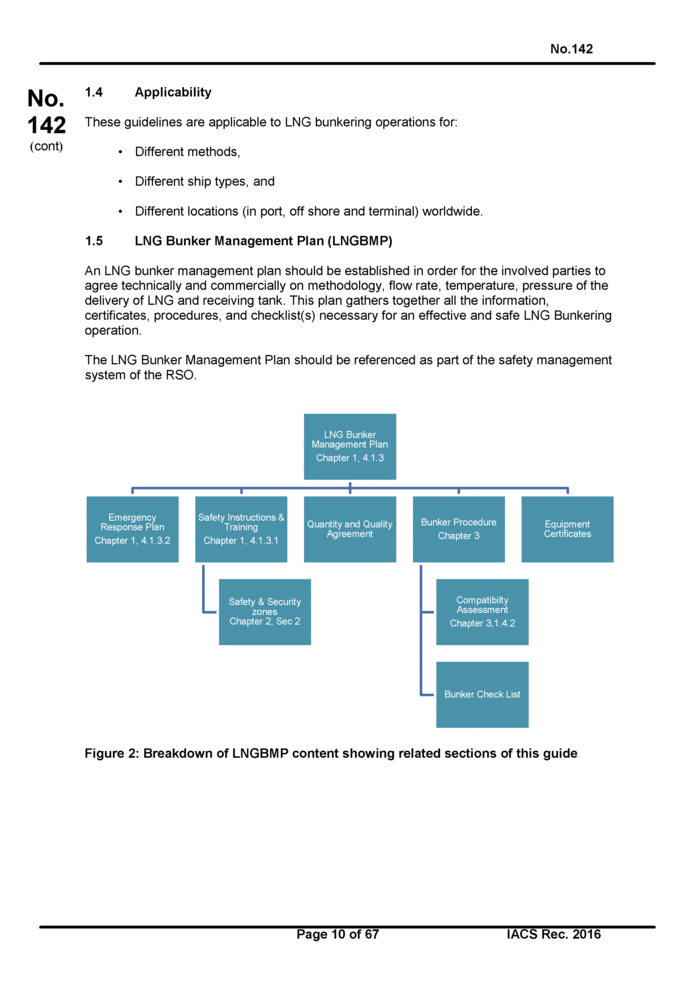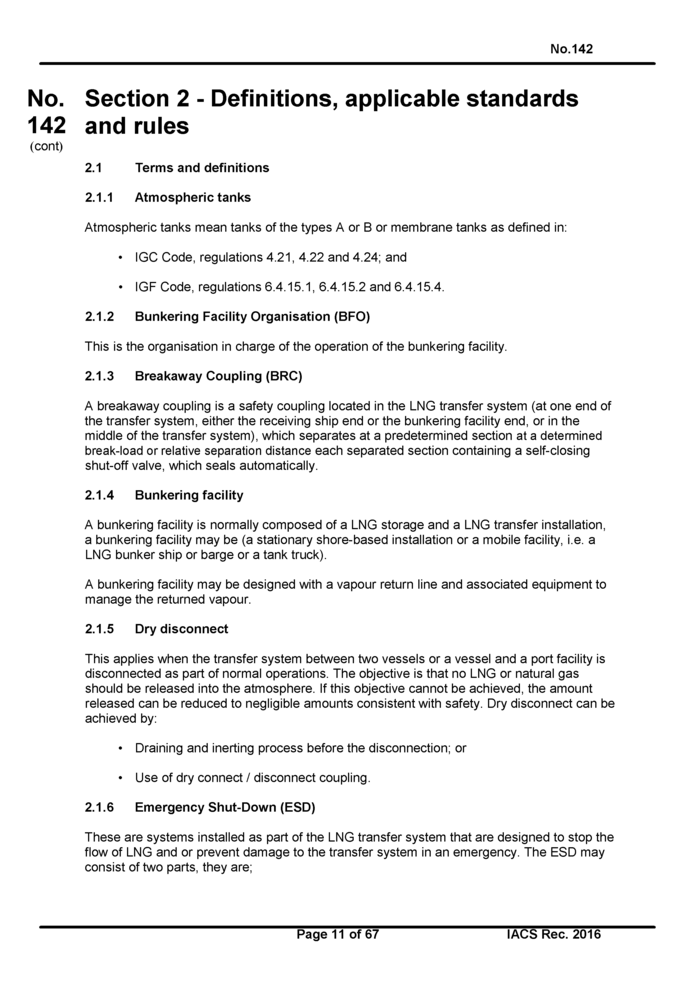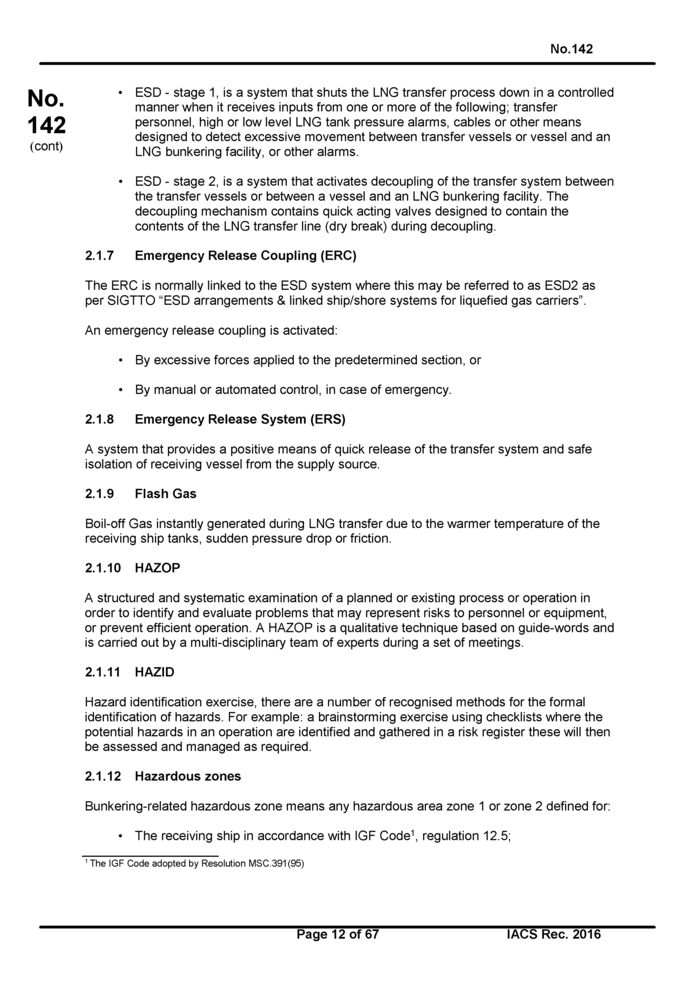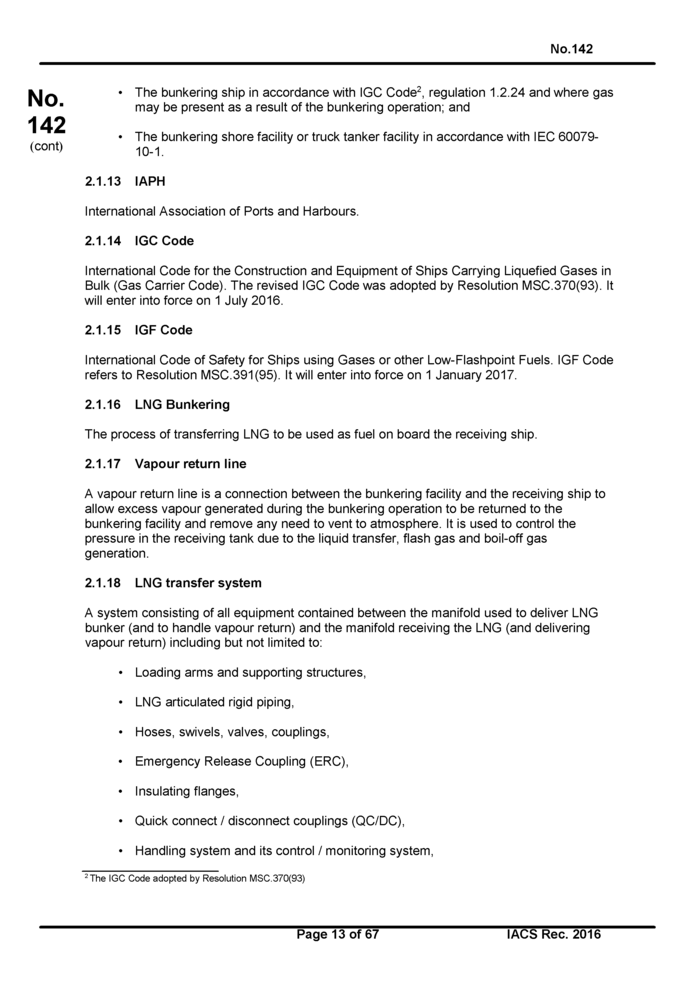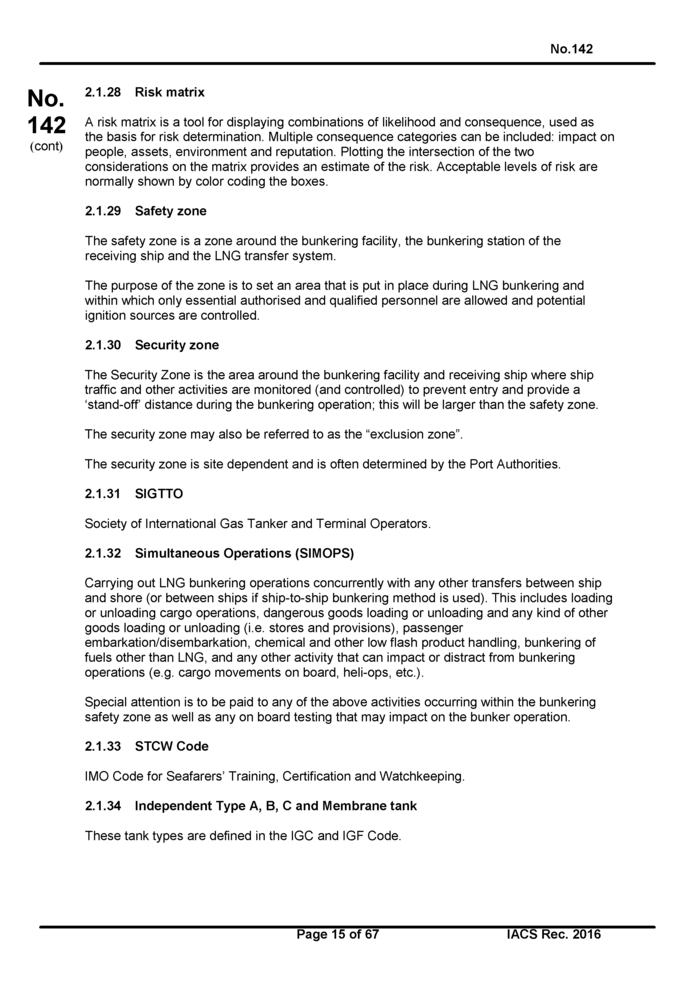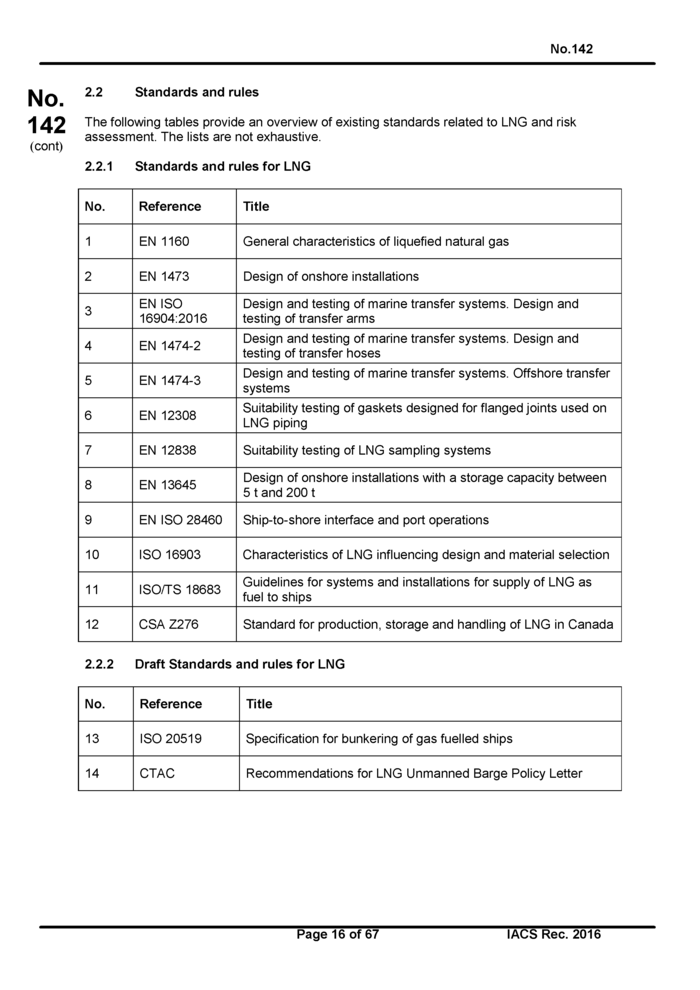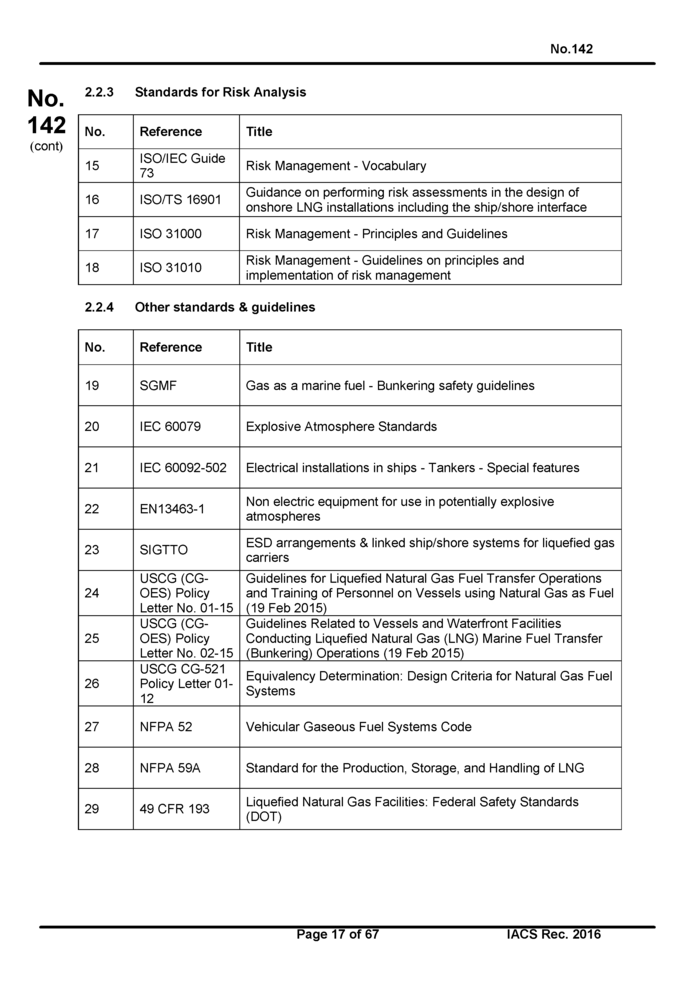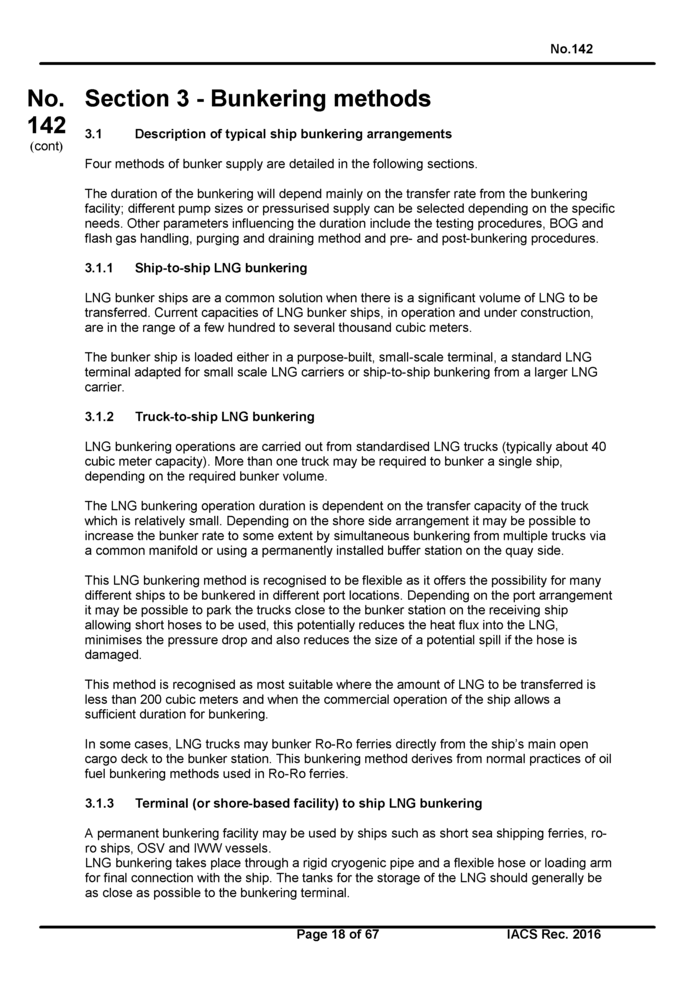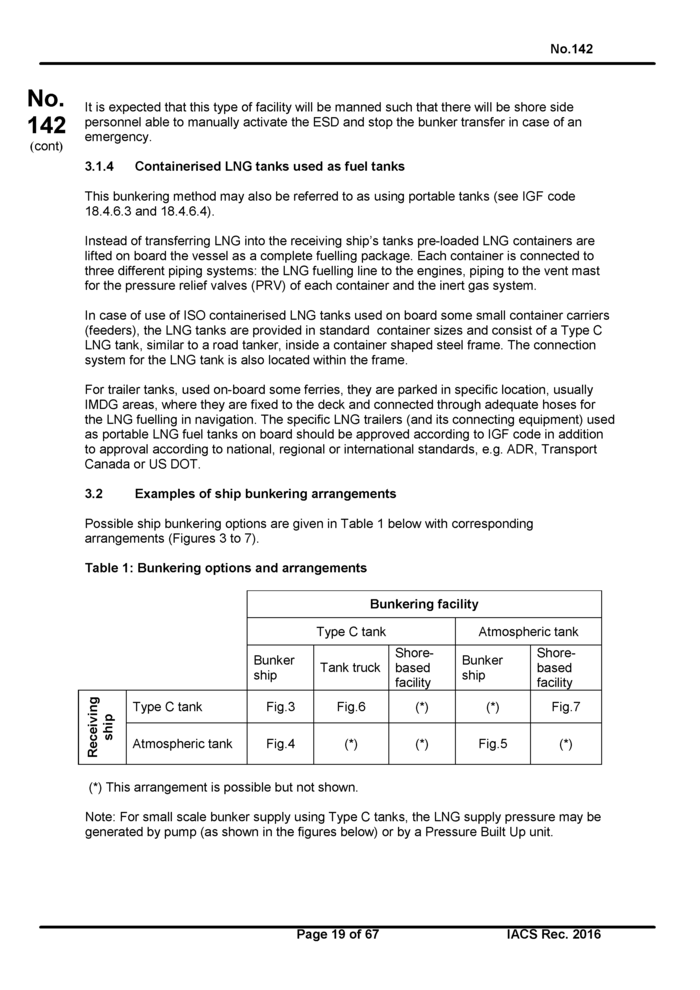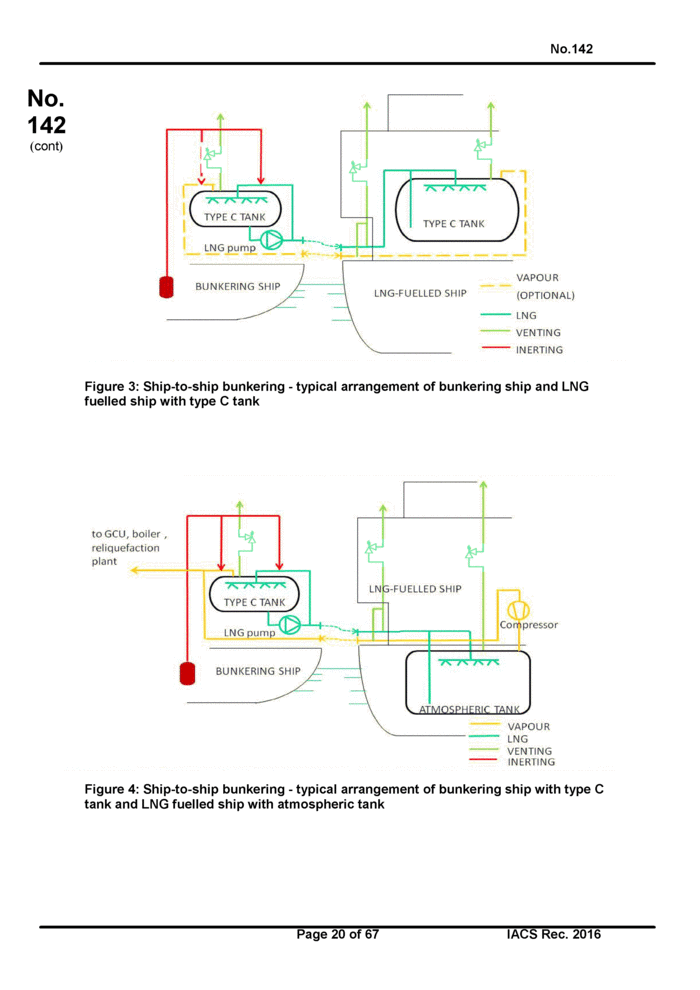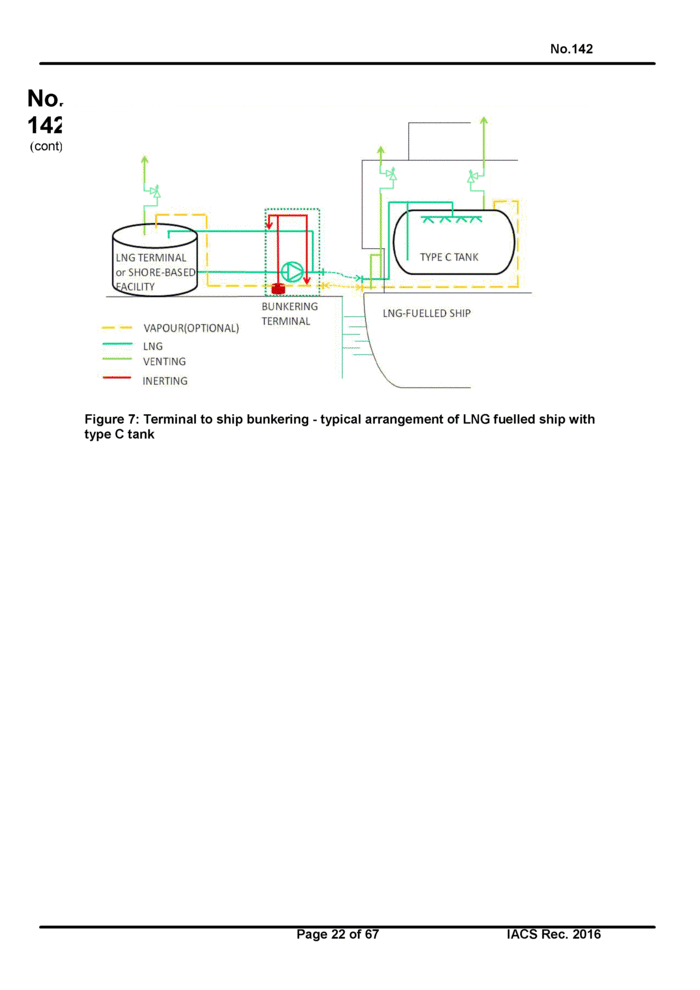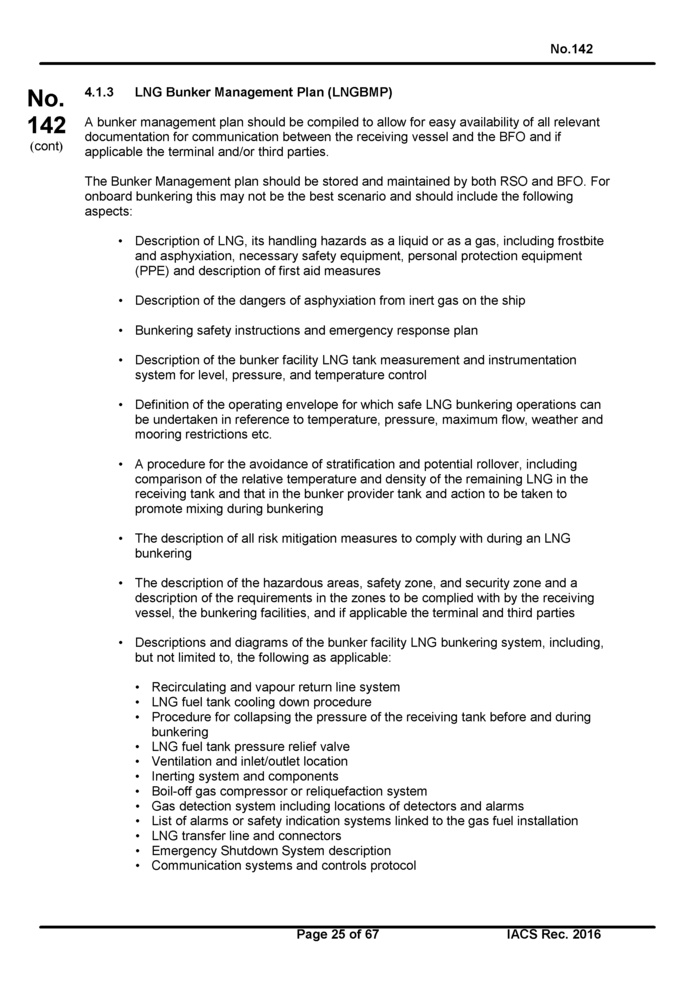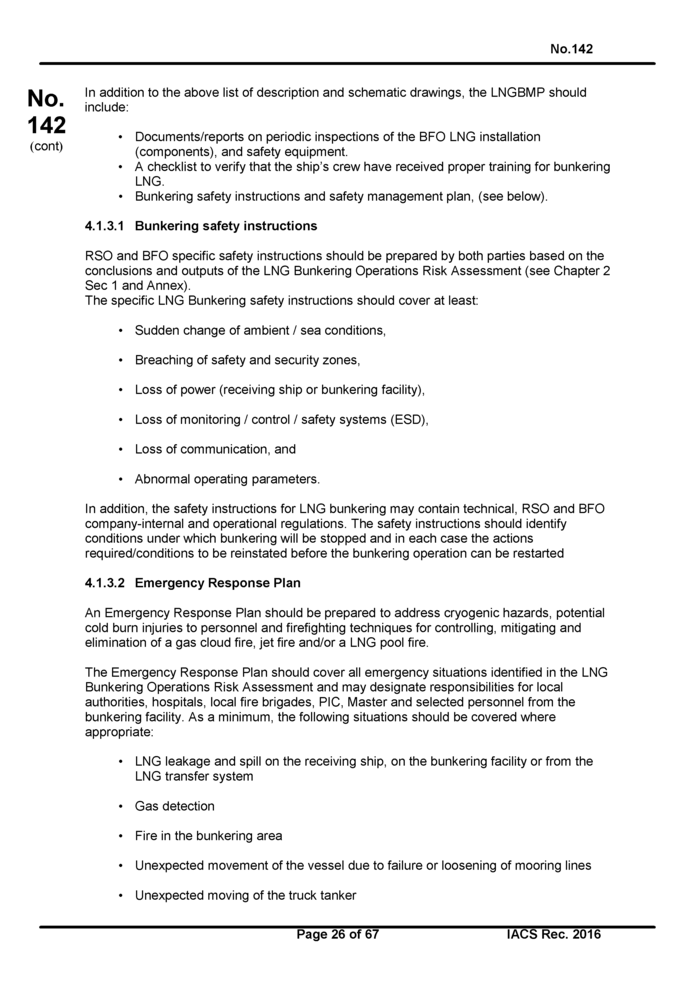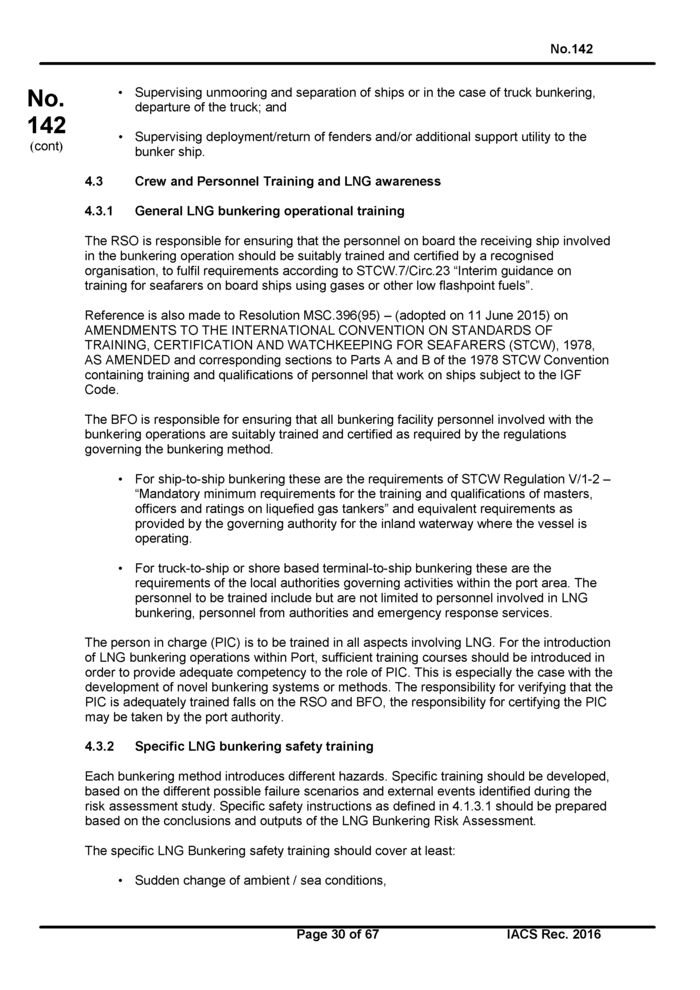No. Table of Contents 142
|
(cont) Chapter 1 |
General |
|
Section 1 |
Application |
|
1.1 |
Introduction |
|
1.2 |
Purpose |
|
1.3 |
LNG Bunkering process and guideline structure |
|
1.4 |
Applicability |
|
1.5 |
LNG Bunker Management Plan (LNGBMP) |
|
Section 2 |
Definitions, applicable standards and rules |
|
2.1 |
Terms and definitions |
|
2.2 |
Standards and rules |
|
Section 3 |
Bunkering methods |
|
3.1 |
Description of typical ship bunkering arrangements |
|
3.2 |
Examples of ship bunkering arrangements |
|
Section 4 |
Responsibilities during LNG bunkering |
|
4.1 |
Responsibilities during planning stage |
|
4.2 |
Responsibilities during bunkering operations |
|
4.3 |
Crew and Personnel Training and LNG awareness |
|
Section 5 |
Technical requirements for bunkering systems |
|
5.1 |
General |
|
5.2 |
Loading arms and hoses arrangements |
|
5.3 |
Couplings and connecting flanges |
|
5.4 |
Leakage detection |
|
5.5 |
ESD systems |
|
5.6 |
Emergency Release Coupling (ERC) |
No. Section 2 - Definitions, applicable standards142 and rules
(cont)
2.1 Terms and definitions
2.1.1 Atmospheric tanks
Atmospheric tanks mean tanks of the types A or В or membrane tanks as defined in:
• IGC Code, regulations 4.21. 4.22 and 4.24; and
• IGF Code, regulations 6 4.15.1, 6.4.15.2 and 6.4.15.4.
2.1.2 Bunkering Facility Organisation (BFO)
This is the organisation in charge of the operation of the bunkering facility.
2.1.3 Breakaway Coupling (BRC)
A breakaway coupling is a safety coupling located in the LNG transfer system (at one end of the transfer system, either the receiving ship end or the bunkering facility end, or in the middle of the transfer system), which separates at a predetermined section at a determined break-load or relative separation distance each separated section containing a self-closing shut-off valve, which seals automatically.
2.1.4 Bunkering facility
A bunkering facility is normally composed of a LNG storage and a LNG transfer installation, a bunkering facility may be (a stationary shore-based installation or a mobile facility, i.e. a LNG bunker ship or barge or a tank truck).
A bunkering facility may be designed with a vapour return line and associated equipment to manage the returned vapour.
2.1.5 Dry disconnect
This applies when the transfer system between two vessels or a vessel and a port facility is disconnected as part of normal operations. The objective is that no LNG or natural gas should be released into the atmosphere. If this objective cannot be achieved, the amount released can be reduced to negligible amounts consistent with safety. Dry disconnect can be achieved by:
• Draining and inerting process before the disconnection; or
• Use of dry connect / disconnect coupling.
2.1.6 Emergency Shut-Down (ESD)
These are systems installed as part of the LNG transfer system that are designed to stop the flow of LNG and or prevent damage to the transfer system in an emergency. The ESD may consist of two parts, they are;
• ESD - stage 1. is a system that shuts the LNG transfer process down in a controlled manner when it receives inputs from one or more of the following; transfer personnel, high or low level LNG tank pressure alarms, cables or other means designed to detect excessive movement between transfer vessels or vessel and an LNG bunkering facility, or other alarms.
• ESD - stage 2. is a system that activates decoupling of the transfer system between the transfer vessels or between a vessel and an LNG bunkering facility. The decoupling mechanism contains quick acting valves designed to contain the contents of the LNG transfer line (dry break) during decoupling
2.1.7 Emergency Release Coupling (ERC)
The ERC is normally linked to the ESD system where this may be referred to as ESD2 as per SIGTTO "ESD arrangements & linked ship/shore systems for liquefied gas carriers".
An emergency release coupling is activated:
• By excessive forces applied to the predetermined section, or
• By manual or automated control, in case of emergency.
2.1.8 Emergency Release System (ERS)
A system that provides a positive means of quick release of the transfer system and safe isolation of receiving vessel from the supply source.
2.1.9 Flash Gas
Boil-off Gas instantly generated during LNG transfer due to the warmer temperature of the receiving ship tanks, sudden pressure drop or friction.
2.1.10 HAZOP
A structured and systematic examination of a planned or existing process or operation in order to identify and evaluate problems that may represent risks to personnel or equipment, or prevent efficient operation. A HAZOP is a qualitative technique based on guide-words and is carried out by a multi-disciplinary team of experts during a set of meetings.
2.1.11 HAZID
Hazard identification exercise, there are a number of recognised methods for the formal identification of hazards. For example: a brainstorming exercise using checklists where the potential hazards in an operation are identified and gathered in a risk register these will then be assessed and managed as required.
2.1.12 Hazardous zones
Bunkering-related hazardous zone means any hazardous area zone 1 or zone 2 defined for:
• The receiving ship in accordance with IGF Code1, regulation 12.5;
' The IGF Code adopted by Resolution MSC 391(96)
• The bunkering ship in accordance with IGC Code2, regulation 1.2.24 and where gas may be present as a result of the bunkering operation; and
• The bunkering shore facility or truck tanker facility in accordance with IEC 60079-10-1.
2.1.13 IAPH
International Association of Ports and Harbours.
2.1.14 IGC Code
International Code for the Construction and Equipment of Ships Carrying Liquefied Gases in Bulk (Gas Carrier Code). The revised IGC Code was adopted by Resolution MSC.370(93). It will enter into force on 1 July 2016.
2.1.15 IGF Code
International Code of Safety for Ships using Gases or other Low-Flashpoint Fuels. IGF Code refers to Resolution MSC.391 (95). It will enter into force on 1 January 2017.
2.1.16 LNG Bunkering
The process of transferring LNG to be used as fuel on board the receiving ship
2.1.17 Vapour return line
A vapour return line is a connection between the bunkering facility and the receiving ship to allow excess vapour generated during the bunkering operation to be returned to the bunkering facility and remove any need to vent to atmosphere. It is used to control the pressure in the receiving tank due to the liquid transfer, flash gas and boil-off gas generation.
2.1.18 LNG transfer system
A system consisting of all equipment contained between the manifold used to deliver LNG bunker (and to handle vapour return) and the manifold receiving the LNG (and delivering vapour return) including but not limited to;
• Loading arms and supporting structures.
• LNG articulated rigid piping.
• Hoses, swivels, valves, couplings.
• Emergency Release Coupling (ERC).
• Insulating flanges.
• Quick connect / disconnect couplings (QC/DC),
• Handling system and its control / monitoring system,
3 The IGC Code adopted by Resolution MSC 370(93)
• Communication system.
• ESD Ship/Shore Link or Ship/Ship Link used to connect the supplying and receiving ESD systems.
It can also include the compressors or blowers intended for the boil-off gas handling system where provided depending on the design of the transfer system. However, liquefaction systems used to maintain pressure in the bunker vessel tanks are not to be considered as part of the LNG transfer system.
2.1.19 MARVS
Maximum Allowable Relief Valve Setting.
2.1.20 MSC
Maritime Safety Committee of the IMO.
2.1.21 Person in Charge (PIC)
The Person in Charge (PIC) is a person who is responsible for the overall management of the bunkering operation. The PIC may also be referred to as Person in Overall Advisory Control (POAC).
2.1.22 PPE
Personal Protective Equipment.
2.1.23 Qualitative Risk Assessment (QuaiRA)
A risk assessment method using relative measure of risk value based on ranking or separation into descriptive categories such as low. medium, high; not important, important, very important; or on a scale, for example from 1 to 10 or 1 to 5.
2.1.24 Quantitative Risk Assessment (QRA)
This is a formalised statistical risk assessment method for calculating a numerical risk level for comparison with defined regulatory risk criteria.
2.1.25 Receiving Ship
Receiving ship is the ship that receives LNG fuel.
2.1.26 Receiving Ship Operator (RSO)
The receiving ship operator (RSO) is the company responsible for the operation of the receiving ship, in particular during the bunkering operations.
2.1.27 Risk
A combination of the likelihood of an event and the consequences if the event occurs.
Page 14 of 67
2.1.28 Risk matrix
A risk matrix is a tool for displaying combinations of likelihood and consequence, used as the basis for risk determination. Multiple consequence categories can be included: impact on people, assets, environment and reputation. Plotting the intersection of the two considerations on the matrix provides an estimate of the risk. Acceptable levels of risk are normally shown by color coding the boxes.
2.1.29 Safety zone
The safety zone is a zone around the bunkering facility, the bunkering station of the receiving ship and the LNG transfer system.
The purpose of the zone is to set an area that is put in place during LNG bunkering and within which only essential authorised and qualified personnel are allowed and potential ignition sources are controlled.
2.1.30 Security zone
The Security Zone is the area around the bunkering facility and receiving ship where ship traffic and other activities are monitored (and controlled) to prevent entry and provide a stand-off distance during the bunkering operation; this will be larger than the safety zone.
The security zone may also be referred to as the "exclusion zone".
The security zone is site dependent and is often determined by the Port Authorities.
2.1.31 SIGTTO
Society of International Gas Tanker and Terminal Operators.
2.1.32 Simultaneous Operations (SIMOPS)
Carrying out LNG bunkering operations concurrently with any other transfers between ship and shore (or between ships if ship-to-ship bunkering method is used). This includes loading or unloading cargo operations, dangerous goods loading or unloading and any kind of other goods loading or unloading (i.e. stores and provisions), passenger embarkation/disembarkation. chemical and other low flash product handling, bunkering of fuels other than LNG, and any other activity that can impact or distract from bunkering operations (e g. cargo movements on board, heli-ops, etc ).
Special attention is to be paid to any of the above activities occurring within the bunkering safety zone as well as any on board testing that may impact on the bunker operation.
2.1.33 STCW Code
IMO Code for Seafarers’ Training. Certification and Watchkeeping.
2.1.34 Independent Type А, В, C and Membrane tank These tank types are defined in the IGC and IGF Code.
Standards and rules
The following tables provide an overview of existing standards related to LNG and risk assessment. The lists are not exhaustive.
2.2.1 Standards and rules for LNG
|
No. |
Reference |
Title |
|
1 |
EN 1160 |
General characteristics of liquefied natural gas |
|
2 |
EN 1473 |
Design of onshore installations |
|
3 |
EN ISO 16904:2016 |
Design and testing of marine transfer systems. Design and testing of transfer arms |
|
4 |
EN 1474-2 |
Design and testing of marine transfer systems. Design and testing of transfer hoses |
|
5 |
EN 1474-3 |
Design and testing of marine transfer systems. Offshore transfer systems |
|
6 |
EN 12308 |
Suitability testing of gaskets designed for flanged joints used on LNG piping |
|
7 |
EN 12838 |
Suitability testing of LNG sampling systems |
|
8 |
EN 13645 |
Design of onshore installations with a storage capacity between 51 and 2001 |
|
9 |
EN ISO 28460 |
Ship-to-shore interface and port operations |
|
10 |
ISO 16903 |
Characteristics of LNG influencing design and material selection |
|
11 |
180Я8 18683 |
Guidelines for systems and installations for supply of LNG as fuel to ships |
|
12 |
CSA Z276 |
Standard for production, storage and handling of LNG in Canada |
|
|
2.2.2 Draft Standards and rules for LNG |
|
No. |
Reference |
Title |
|
13 |
ISO 20519 |
Specification for bunkering of gas fuelled ships |
|
14 |
CTAC |
Recommendations for LNG Unmanned Barge Policy Letter |
IACS Rec. 2016
|
No. |
5.7 |
Communication systems |
|
142 |
5.8 |
Bunkering transfer rate |
|
(cont) |
5.9 |
Vapour return line |
|
|
5.10 |
Lighting |
|
No. |
Chapter 2 |
Risk Assessment |
|
142 |
Section 1 |
LNG Bunkering operations risk assessment |
|
(cont) |
1.1 |
General |
|
|
1.2 |
Risk assessment approach |
|
|
1.3 |
Risk criteria |
|
|
1.4 |
Guidance on a typical Risk Assessment for LNG bunkering operations |
|
|
Section 2 |
Safety and security zones |
|
|
2.1 |
General |
|
|
2.2 |
Hazardous area classification |
|
|
2.3 |
Safety zones |
|
|
2.4 |
Security zones |
|
No. |
Chapter 3 |
Functional and General Requirements for LNG Bunkering Operation |
|
142 |
Section 1 |
Pre-bunkering phase |
|
(cont) |
1.1 |
Definition |
|
|
1.2 |
Goal |
|
|
1.3 |
Functional requirements |
|
|
1.4 |
General requirements |
|
|
1.5 |
Preparation for bunker transfer |
|
|
1.6 |
Pre-bunkering checklist |
|
|
1.7 |
Connection of the transfer system |
|
|
Section 2 |
Bunkering phase |
|
|
2.1 |
Definition |
|
|
2.2 |
Goal |
|
|
2.3 |
Functional requirements |
|
|
2.4 |
General requirements |
|
|
Section 3 |
Bunkering completion phase |
|
|
3.1 |
Definition |
|
|
3.2 |
Goal |
|
|
3.3 |
Functional requirements |
|
|
3.4 |
Draining, purging and inerting sequence |
|
|
3.5 |
Post-bunkering documentation |
IACS Rec. 2016
|
No. |
Annex: |
Guidance on HAZID and HAZOP for LNG bunkering operations |
|
142 |
Section 1 |
HAZID for LNG bunkering |
|
(cont) |
1.1 |
Objectives |
|
|
1.2 |
Scope |
|
|
1.3 |
Process |
|
|
1.4 |
Technique |
|
|
1.5 |
Guidewords |
|
|
Section 2 |
HAZOP for LNG bunkering operations |
|
|
2.1 |
Definition |
|
|
2.2 |
Process |
|
|
2.3 |
Scope |
|
No. Chapter 1 - General 142 |
|
(cont)
Section 1 |
Application |
|
Section 2 |
Definitions, applicable standards and rules |
|
Section 3 |
Bunkering methods |
|
Section 4 |
Responsibilities during LNG bunkering |
|
Section 5 |
Technical requirements for bunkering systems |
|
KC5 Rec. 2016
Section 1 - Application
1.1 Introduction
LNG bunkering is developing worldwide in line with the increase of use of natural gas as a fuel compliant with environmental legislation.
This guideline provides recommendations for the responsibilities, procedures and equipment required for LNG bunkering operations and sets harmonised minimum baseline recommendations for bunkering risk assessment, equipment and operations.
These guidelines do not consider commercial aspects of the bunker transfer such as Bunker Delivery Notes and measurement of quantity or quality of LNG.
1.2 Purpose
The purpose of these guidelines is mainly to define and cover the additional risks associated with bunkering LNG and to propose a methodology to deal with those additional risks in order to provide a similar level of safety as is achieved for traditional oil fuel bunkering operations.
This document is designed to complement the requirements from the existing applicable guidelines and regulations, such as port and terminal checklists, operator s procedures, industry guidelines and local regulations. This guide provides guidance to clarify the gaps that have been identified in the existing guidance and regulations. In particular, the following items are covered:
• The responsibility of different parties involved in the LNG transfer,
• The LNG bunkering process,
• SIMOPS
• Safety distances,
• QRA and HAZID
1.3 LNG Bunkering process and guideline structure
LNG bunkering is the process of transferring LNG fuel to a ship from a bunkering facility.
The sequence for a bunkering operation carried out between two parties for the first time is described in the following diagram; the references identify the applicable sections of the guideline.
IACS Rec. 2016
•Safety and Risk Assessment phase
5
Ш
3
3
5'
Q
T3
3-
CJ
c/i
№
•HAZID & HAZOP, QRA, Safety & Security zones •Chapter 2 & Annex
•Safety and Risk Assessment conclusions undertaken
|
•Preparation for safe bunkering •Chapter 3 Section 1
•Inerting, coupling and testing •Chapter 3 Section 1
•Monitoring and management of the LNG transfer •Chapter 3 Section 2
•Draining, purging, safe storage of the hose and couplings •Chapter 3 Section 3 |
|
|
Figure 1: Bunkering process |
•Administrative authorisation & Contractual agreement •Chapter 3 Section 1
•Safety and Risk Assessment applied
О
Q
о
CJ
о
3
£L
TJ
3-
CJ
v>
<D
•Selection of equipment, Training, Check List •Chapter 3 Section 1
Page 9 of 67
1.4 Applicability
These guidelines are applicable to LNG bunkering operations for:
• Different methods,
• Different ship types, and
• Different locations (in port, off shore and terminal) worldwide.
1.5 LNG Bunker Management Plan (LNGBMP)
An LNG bunker management plan should be established in order for the involved parties to agree technically and commercially on methodology, flow rate, temperature, pressure of the delivery of LNG and receiving tank This plan gathers together all the information, certificates, procedures, and checklist(s) necessary for an effective and safe LNG Bunkering operation.
The LNG Bunker Management Plan should be referenced as part of the safety management system of the RSO.
|
|
Compatibly Assessment Chapter 3.1.4 2 |
Figure 2: Breakdown of LNGBMP content showing related sections of this guide









